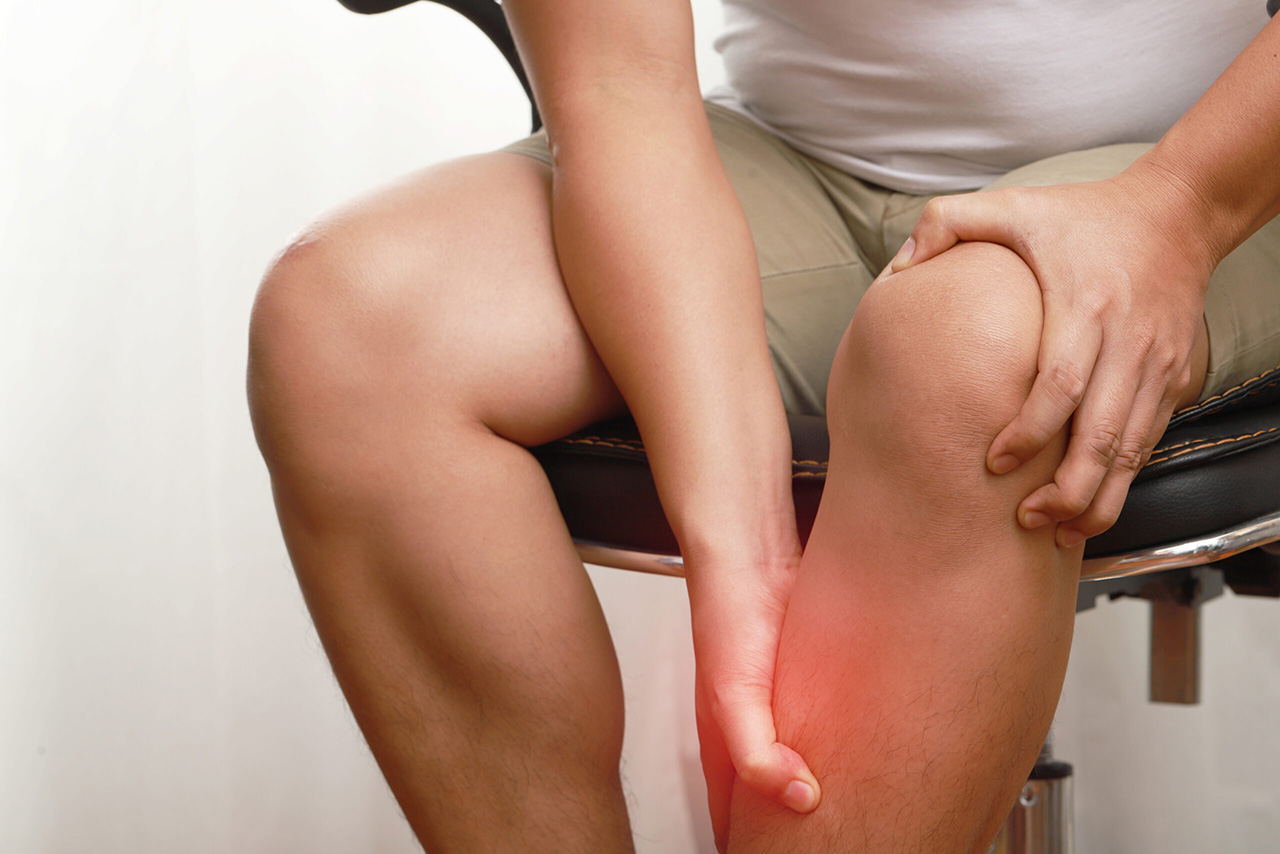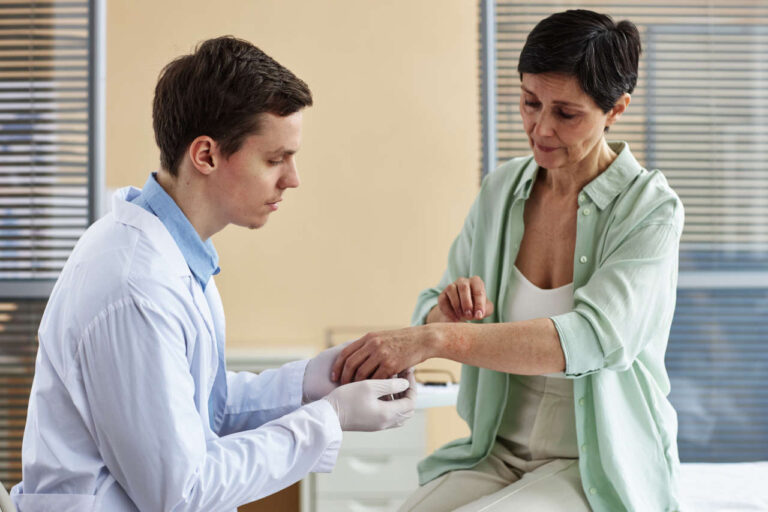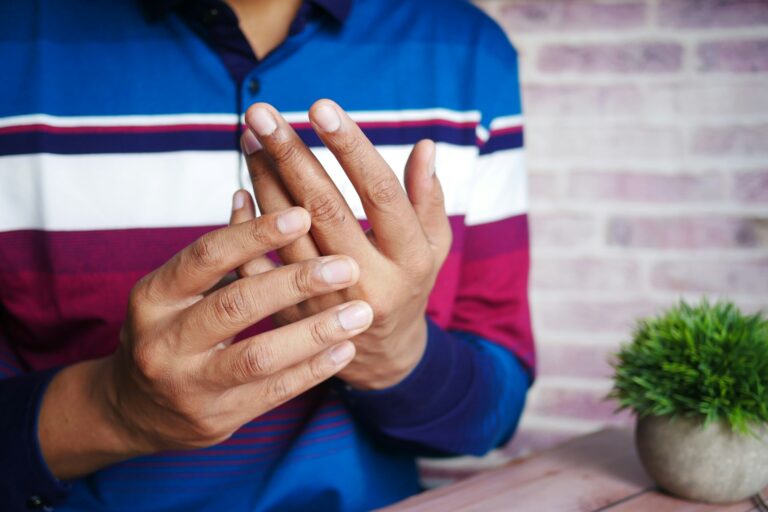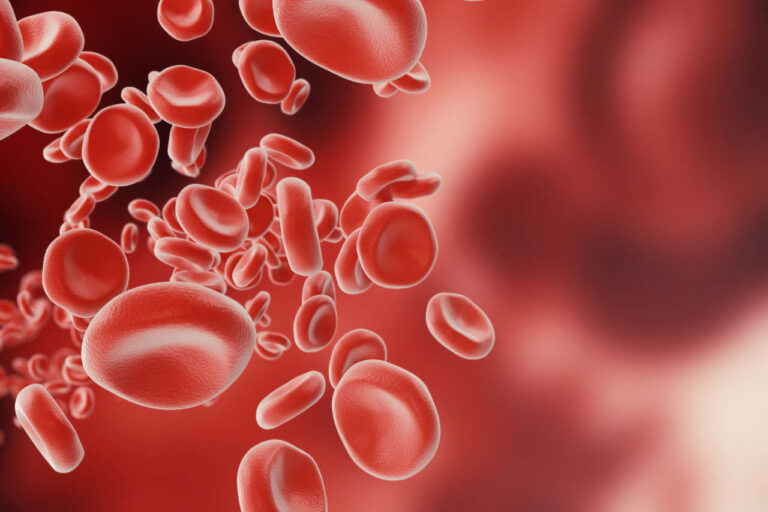
Myositis originates from two words: “myo,” meaning muscle, and “itis,” meaning inflammation. Thus, myositis refers to a group of diseases that cause inflammation of muscles.
Myositis symptoms include pain, swelling, and overall weakness.
What Triggers Myositis?
Many people have experienced delayed onset muscle soreness (DOMS) after strenuous exercise, but this condition is temporary and subsides with rest. Other conditions that cause myositis include infection, muscle injury from medications, genetic diseases, autoimmune conditions, electrolyte imbalances, thyroid disease, and drug side effects.
Myositis is commonly used to refer to chronic inflammation that mainly results from autoimmune conditions in which the body’s immune system starts attacking its own tissues. Myositis resulting from autoimmune diseases is also known as idiopathic inflammatory myositis (IIM). In contrast to other kinds of myopathies, IIM is more serious and associated with severe complications.
Types of Myositis
The different types of myositis can be classified under four sub-types:
- Polymyositis (PM)
- Dermatomyositis (DM)
- Immune-mediated necrotizing myopathy (IMNM)
- Sporadic Inclusion Body Myositis (sIBM)
Get IVIG Copay Assistance
IVIG Financial AssistancePolymyositis (PM)
Polymyositis most commonly affects adults in their 30s to 50s and is more common in women than in men. It affects many groups of muscles (“poly” means many), the most common ones being closer to the trunk of the body (i.e., shoulders, upper arms, neck, upper back, thighs, hips, and thigh areas). Muscle weakness will begin with these muscles and may spread to other parts of the body.
PM patients may also experience breathing problems and trouble swallowing if muscles in the chest wall or neck are affected.
Dermatomyositis (DM)
Dermatomyositis can affect people of any age or sex but is more common in women than in men. DM may occur in children, in which case it is referred to as juvenile dermatomyositis. Like polymyositis, dermatomyositis causes muscles to become inflamed in several areas, but it starts with a body rash and dry, scaly skin. The rash is predominantly on the eyelids, nose, cheeks, back, upper chest, elbows, knees, and knuckles.
Immune-mediated Necrotizing Myopathy (IMNM)
IMNM is characterized by signs of necrosis, or cell death, in muscles which leads to severe weakness and fatigue. People with necrotizing myopathy experience weakness around the trunk of the body (i.e., forearms, thighs, hips, shoulders, neck, and back).
Sporadic Inclusion Body Myositis (sIBM)
sIBM is the most common myopathy in people over age 50 and is more common in men than in women. Unlike other types of myositis, symptoms of sIBM develop gradually over several years. For this reason, patients may experience symptoms for many years before they are diagnosed.
People with this condition find difficulty performing day-to-day activities, such as walking and climbing stairs. Muscles most often affected are those at the front of the thighs, those that elevate the feet, and those in the hips, fingers, wrists, upper arms, shoulders, neck, and back. Many patients will notice shrinking (atrophy) in the arms and thighs as the muscles become weaker. sIBM does not typically respond to immunosuppressive therapy, unlike other inflammatory myopathies.
Myositis Symptoms
Since myositis primarily involves muscle tissue, muscle weakness is the most common symptom. Other symptoms include muscle swelling and pain.
Almost all symptoms of myositis worsen gradually over time. People with myositis may or may not feel pain initially, but weakness and fatigue adversely impact the quality of life. Large groups of muscles, particularly those supporting shoulders, hips, thighs, back, and neck are significantly affected.
Over time, the weakness in muscles becomes so severe that it disrupts normal movement, resulting in falls, difficulty getting up after a fall, difficulty climbing stairs, and difficulty getting up from a chair.
Treatment Info
Get IVIG Prior AuthorizationCauses of Myositis
Infections
The most common infectious cause of myositis is viral infections. Rarely, other organisms like bacteria and fungi can also cause myositis. Viruses or bacteria directly invade muscle tissue or release substances that damage muscles.
Injuries
Vigorous exercise can lead to muscle pain, swelling, and weakness for up to days after a workout. Inflammation contributes to these symptoms, making it a form of myositis. Myositis symptoms and injury after exercise usually resolve completely with rest.
Drugs
Certain medications can cause temporary muscle damage. These include:
Statins: Statins is a group of cholesterol-lowering medications. Potentially serious side effects include myositis and rhabdomyolysis. People on statins are advised to avoid grapefruit juice as it can interfere with the body’s ability to break down statin medications. This can lead to an increase in the level of statins in the blood, possibly leading to side effects.
Colchicine: Colchicine is commonly used to prevent or treat gout flareups. One of the rare side effects of taking colchicine is myopathy. Symptoms of myopathy are similar to those of myositis.
Plaquenil: Plaquenil is used to prevent or treat malaria caused by mosquito bites. It is also used to treat lupus or rheumatoid arthritis. A possible side effect is myopathy (including paralysis or neuromyopathy). Note, however, that Plaquenil-induced myopathy is rare, with the risk being higher the longer you’re on the medication and the higher your dose. Because of this risk, routine monitoring is advised in people on long-term therapy.
Alpha-interferon: Alpha-interferons are used to treat various cancers and virus infections such as hepatitis B. Possible side effects include myositis and myopathy (including cardiomyopathy).
Alcohol: Heavy drinking is associated with myopathy, causing symptoms of muscle pain and weakness. It can either be acute, after a person has binged on alcohol or chronic, developing over time with heavy alcohol use.
Cocaine: Cocaine is a highly addictive substance that affects the central nervous system. It adversely affects muscle cells and is known to cause myopathy and rhabdomyolysis.
Myopathy can occur right after starting one of these medications or may occur after months to years of use. Most cases are reversible upon drug discontinuation if recognized early.
Myositis Diagnosis
There are a series of different tests that can help diagnose myositis. These include:
Blood Tests
Muscles contain several proteins that are continuously released into the blood as our body makes new cells and fixes damaged cells. When there is an increase in muscle cell damage, the levels of these proteins increase in the blood as well. An elevated level of muscle proteins can help diagnose myositis. The most prominent ones that are tested for in myositis are creatine kinase (CK), and aldolase. Other blood tests, such as antinuclear antibodies (ANA), check for abnormal antibodies that help identify if an autoimmune condition is present.
Electromyography (EMG)
EMG studies test the specific response of muscles to electrical nerve signals. By doing so, EMG identifies muscles that are weak or damaged by myositis.
Muscle Biopsy and Skin Biopsy
These two tests are the most accurate tests for diagnosing myositis. A small incision is made and a small sample is removed for testing. Muscle and skin biopsies are often the most definitive way to diagnose myositis.
MRI
MRI is non-invasive and uses a scanner to create images of muscles. An MRI scan can help identify areas of myositis and changes in muscles over time.
Get IVIG Copay Assistance
Speak to a SpecialistIs Myositis Curable?
Currently, there is no cure for myositis, but the disease can be managed to reduce inflammation and prevent muscle weakness from progressing. Certain medications and lifestyle changes can slow down its progression.
Treatment of Myositis
Myositis varies widely from one patient to another, so no single treatment will work for everyone. There are a number of medications available that may be used individually or in combination.
Immunosuppressants
Immunosuppressants are drugs that inhibit the activity of the immune system and prevent immune cells from attacking healthy tissue. Immunosuppressants used in treating myositis include methotrexate, azathioprine, mycophenolate mofetil, cyclosporine, tacrolimus, cyclophosphamide, and hydroxychloroquine.
Corticosteroids
Corticosteroids include prednisone, methylprednisolone, and other steroids.
Anti-Inflammatory Drugs
Non-steroidal anti-inflammatory drugs (NSAIDs), such as aspirin and ibuprofen help fight inflammation and provide pain relief in myositis.
Intravenous Immunoglobulin (IVIG)
Biological therapies have earned significant popularity over the last couple of years. IVIG is a blood product derived from human plasma that contains antibodies to help control inflammation. It is considered an effective therapy in controlled trials in patients with polymyositis, dermatomyositis, and infectious myositis.
IVIG is especially beneficial for dermatomyositis and immune-mediated necrotizing myopathy. But the clinical evidence is more limited for polymyositis. In addition, IVIG is not typically used in sIBM.
Emerging Treatments for Myositis
Recent advances in the treatment of myositis are expanding options for patients who do not respond well to conventional therapies like corticosteroids and immunosuppressants. Several emerging therapies show promise:
- Biologics: Targeted therapies such as rituximab (an anti-CD20 monoclonal antibody) have shown benefit in some patients, particularly those with dermatomyositis or polymyositis who are refractory to standard treatment. Other biologics under investigation include tocilizumab (an IL-6 receptor antagonist) and abatacept (a T-cell costimulation blocker).
- JAK Inhibitors: For patients with refractory dermatomyositis, Janus kinase (JAK) inhibitors, such as tofacitinib and ruxolitinib, have demonstrated encouraging results in early studies. These oral agents work by modulating inflammatory pathways and may help reduce skin and muscle inflammation.
- Gene and Cellular Therapies: Clinical trials are exploring gene-editing techniques and cell-based therapies, such as mesenchymal stem cell infusions, especially for sporadic inclusion body myositis (sIBM) and immune-mediated necrotizing myopathy (IMNM). While still experimental, these approaches aim to regenerate damaged muscle tissue or correct underlying immune dysfunction.
As research continues, these innovative therapies may offer more personalized and effective options for managing difficult cases of myositis.
Consult an IVIG Specialist
The Best IVIG Home Infusion | Get IVIG Treatment AssistanceWhat Is the Life Expectancy of Someone With Myositis?
The prognosis for different forms of myositis varies greatly and can depend on the presence of other conditions. While sporadic inclusion body myositis is a progressive disease, life expectancy is usually the same as for those without the disease. However, for dermatomyositis, polymyositis, and necrotizing myopathy, the progression of the disease is more complicated and harder to predict.
According to The Myositis Association, more than 95% of these patients are still alive more than five years after diagnosis. Many experience only one period of acute illness in their lifetime, while others struggle with symptoms for years.
How Do I Know if I Have Myositis?
Muscle weakness is the main symptom of myositis. In inflammatory myositis, weakness worsens over weeks and months and the weakness affects large muscle groups, including the neck, shoulders, hips, and back. Muscles on both sides are usually affected.
People with myositis often face difficulty getting up from a chair or climbing stairs. If you experience progressive weakness, with or without muscle pain, it is best that you consult your health care provider right away.
Can Myositis Go Away on Its Own?
Like other inflammatory and autoimmune diseases, myositis does not go away on its own. Therefore, its management focuses on preserving muscle tissue by slowing down disease progression, mitigating muscle pain, and improving quality of life.
Can Myositis Be Fatal?
Myositis is a progressive disease, meaning it worsens with time unless it is treated aggressively. Without the right treatment, it can lead to disability, and eventually, death. Therefore timely therapy is key so that progression can be slowed and quality of life can be improved.
Consult an IVIG Specialist
The Best IVIG Home Infusion | Get IVIG Treatment AssistanceIs Myositis Associated With COVID-19?
Recent findings have indicated COVID-19 can be associated with viral myositis. COVID-19 induced myositis may vary in presentation, from dermatomyositis to rhabdomyolysis.













